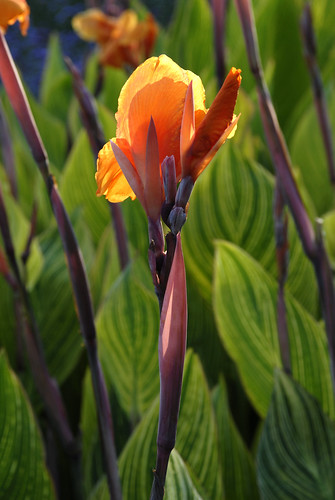Tip of the Week: Become Aware of Your Garden’s Microclimates
Posted in Gardening Tips on November 9 2009, by Sonia Uyterhoeven
 |
Sonia Uyterhoeven is Gardener for Public Education. Join her each weekend through November 15 for home gardening demonstrations on a variety of topics in the Home Gardening Center. |
 With all of the crazy weather we’ve had this year, there has been a great deal of discussion of how weather and climate affects the plants we grow and cherish. This reminds me of the importance of microclimates in the garden and how it allows us to often successfully push the vegetative envelope.
With all of the crazy weather we’ve had this year, there has been a great deal of discussion of how weather and climate affects the plants we grow and cherish. This reminds me of the importance of microclimates in the garden and how it allows us to often successfully push the vegetative envelope.
Recently a woman came to a Home Gardening Demonstration that I was giving on herbs and herbal vinegars. We were looking at a collection of healthy rosemary I was growing in containers, a beautiful, blue upright cultivar called ‘Tuscan Blue’. We then wandered over to another section of the garden where a less robust specimen was struggling in a mixed border.
Rosemary, I explained, is borderline hardy in the New York area. We generally keep it in the ground over winter (it is a perennial herb) and then come back and check on it in the spring to see how it has fared. Usually, it is in such a sorry state that we end up removing it and replanting it with a specimen that has been protected in our greenhouses.
“Oh!” she exclaimed, “I had rosemary that flourished at my home for 5 or 6 years, and it never required any winter protection.” She then proceeded to explain that her rosemary had been situated in an area of her garden that was bordered by a cement walkway, which absorbed heat and warmed the bed. A few feet away, the white walls of the neighbor’s house reflected a fair amount of light into the border.
She had found a perfect microclimate for successfully overwintering her rosemary and other Mediterranean plants. The area provided shelter from damaging winter winds, good drainage, and just enough additional warmth to escort her rosemary through the chilly winter months.
This story reminded me of a friend’s New Jersey garden. The brick house’s laundry room heat vent opened up onto a section of the garden where he planted cannas (pictured), and he never had to lift them in the autumn. They flourished in their niche.
Had he planted a rhododendron in the same spot, the results would have been disastrous. The warm air would not have allowed the evergreen foliage to harden off for the winter, and the plant would have most likely suffered from winter burn and desiccation.
Microclimates beg the gardener to make a sensible choice, to assess the environment before choosing a specimen to reside there.
Pay attention to your compass. Southern exposures are the hottest and are ideal for tropical plants. Plants on the west side of your home will generally flower earlier due to the warm afternoon sun, while the same plants will flower slightly later, yet for a longer period of time, in an eastern exposure with the gentle morning sun.
Many types of hydrangeas form their buds on old growth (formed in the previous season). These overwintering flower buds can easily get damaged if they are tricked by a warm spell in the middle of winter and prematurely open. Avoid a warm southern exposure and plant them in a sheltered northern or eastern exposure so that they will warm up slowly in the spring.
The same rule applies with shallow-rooted perennials such as coral bells (Heuchera). Warm winter sun in a southern exposure can thaw the ground, which then freezes up again with colder nighttime temperatures, causing the soil to expand and contract. The shallow roots of coral bells generally cannot keep it anchored with such changes, and you end up with plant carcasses strewn over the bed.
Above all, gardening is about experimentation. Don’t be afraid to move your plants around if they are not flourishing in a particular site (spring and fall are the best times to transplant). Plants are very responsive. Adventurous experimentation and heeding your plant’s needs will transform you into a more seasoned gardener and a better plant parent.

